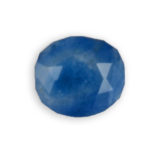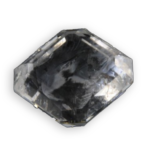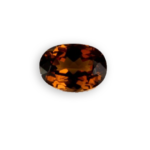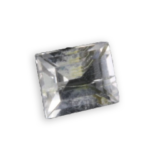
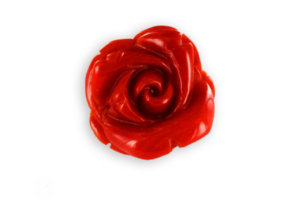
coral
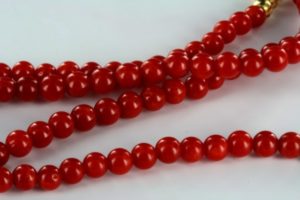
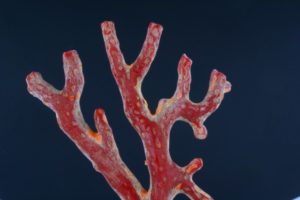
red coral branch
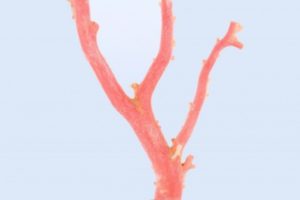
pink coral branch from the Chinese sea
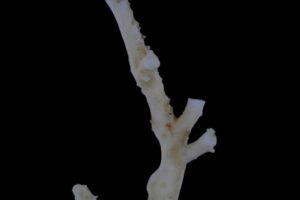
white coral branch
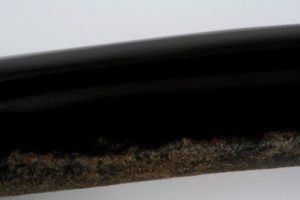
black coral from Dominican Republic
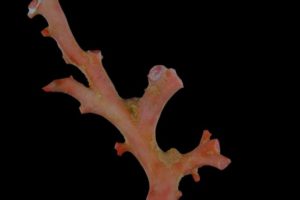
pink coral branch
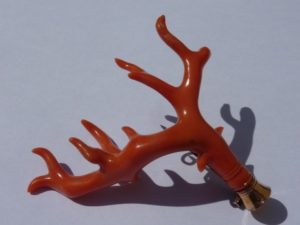
coral branch mounted as breastpin
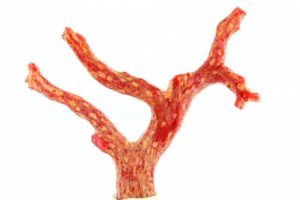
red coral branch from Corsica France
Detailed sheet
coral
For the geologist, the mineralogist and the gemologist, it is neither a mineral or a fossil, or even a rock. This is the central limestone axis around which small polyps have developed, they secrete it and shelter there. These are animals of the Coelenterata phylum in the shape of a small cylinder whose mouth is surrounded by eight tentacles and it is used to capture food particles. All polyps of the same basal plate communicate via their stomachs and each, with the calcareous molecules that exudes, helps to raise the common skeleton that ramifies into branches.
The importance of their calcareous structures can be considerable, forming atolls, barrier reefs (Great Barrier Reef of Australia, 300 m high).
It has been known since ancient times because of its beautiful red color and then regarded as a mere “stone” of seabed with curious shapes, called “daughter of the sea”, it was also believed to be a marine”root” air-hardening. During the Renaissance, it was described as a shrub growing in the marine environment. It was not until 1784 when Cavolini learned that this is an animal, but it would not be taken so seriously.
Finally, in 1827, a Navy doctor, Peyssonnel, observed in vases filled with sea water what was claimed to be the flowering of coral, “which flourished in the water and hardened in the air or when touched with the hand.” He put the vase with water near a heat source and saw all these “bugs” thrive, then made water boil and then they got out of their cells and extend their legs, which had led Marsigli to believe that they were petals of a flower. However, two scientists, Jussieu and Reaumur attempted to show that this conclusion was wrong and it would take fifteen years more to Peyssonnel to prove the correctness of its conclusions.
Its name comes from the Latin “corallum” or “ corallium” according to sources.
The Corals that interest us here are not to be confused with the tropical coral reef builders and part of another class: the scleractinian.

CHEMICAL CHARACTERISTICS
Ca[CO3]
organic calcium carbonate

PHYSICAL CHARACTERISTICS
Main color
red
Other colors
white, blue, grey, black, pink
Color of streak
white
Luster
vitreous, waxy
Hardness
3.0 to 4.0
Density
2.60 to 2.70
Cleavage
none
Fracture
uneven

OPTICAL PROPERTIES
Transparency
opaque
translucent in thin slices for the red and pink coral
Refractive index
1.485 - 1.660
Double refraction
0.160
strong only for the red and white
visible double refraction
No
Pleochroism
absent
Number of colors
1
Absorption spectrum
495
Fluorescence
weak
purple, white

CRYSTALS PROPERTIES
microcrystalline structure

OTHER INFORMATIONS
Astrological sign
Capricorn, Gemini, Leo, Libra
Exploited
sites
They are found in warm seas around the world: in the Mediterranean: Sicily, Calabria, Sardinia, Tunisia and Algeria (Coral Coast), Spain (Bay of Biscay), in Corsica and in the Bay of Biscay to the Cape Verde Islands , Malaysia, southwest Japan, the Persian Gulf, Red Sea, the United States, Australia (Coral Sea, northeast) … at a depth between 50 and 200 meters ( 164 to 650 feet ).
It was used to drag them on the sea bottom at a depth of several meters, and up to 300 meters (1000 feet approx. ), using nets attached to beams, or by diving, but now small submarines are used.
use in jewelry
In its raw state, it is mat and takes a shine by polishing with rottenstone on felt. The jewelers creft necklaces of pierced branches and polished balls, cabochons and cameos. The Chinese and the Japanese know how to creft some remarkable sculptures, up to 40 cm (16 inches ) with a thickness of 5 to 6 cm (2 – 2.5 inches ): birds in trees, graceful girls, peacocks …
Gemologists use only the branched trunks and distinguish, according to the intensity of staining, five varieties: foam blood, flower blood, first blood, second blood, third blood. The white coral is considered “female” and the ebony black is called “antipathes”.
It is in Italy, in Torre del Greco, near Naples, which three-quarters of the world production is worked and also, some appellations of Italian origin are used: bianco (pure white), pelle d’angelo (light pink), rosa pallido (pale pink), rosa vivo (pink), secondo colore (salmon color), rosso (red), rosso scuro (dark red), ariscuro (very dark red), carbonetto (oxblood red, darkest red). The most popular color is pink, pelle d’angelo : “angel skin”, preferred for making necklaces for young girls. The dark black coral, named “akabar”, “accabar” or “Royal Reef”, native of Southeast Asia, is the outer horny skeleton of a very different kind of coral.
In 1958, Hawaiian fishermen found a very dark and very porous “akoa eleele” which gave remarkable jewelry by polishing it with pumice and water. This variety is now banned from fishing, its structure is keratinous, its density and hardness is much lower.
Some white corals with light pink spots are cut in balls or polished retaining their natural form. A red, blue or purple, porous coral from Cameroon, it’s named “akori”.
The red-brown, brown and yellow coral is not very sought and if it is very stitched, perforated by worms (“dead coral”, “coral rotten”) is rejected.
Highly perforated, it is the “tarraille”.
In Italy and in Corsica, they were made into amulets in the shape of a closed fist with the exception of the little finger and index finger that were sticking out like horns which prevented bad luck to be casted by a third person.
Daily care
and precautions
Coral is sensitive to acids, lemon, vinegar. Its maintenance is done with salt water followed by rinsing with distilled water to avoid calcium deposits. It is sensitive to friction, the relief cameos disappear rather quickly because the coral is not very hard. Some advised to feed him with milk or almond oil to protect it.
imitations and
treatments
There are known imitations, made of powdered gypsum or marble agglomerated with fish glue recolored by cinnabar or minium, which are difficult to detect except for the absence of parallel zones of color more or less marked.
Also the colored “tagua” is known, a very hard nut of a tree of tropical America that is also used to make buttons. It is imitated by glass, porcelain, bone, hard rubber, lacquer or plastic material (galalithe, bakelite). The “pressed coral” consists of real coral powder mixed with resin and then shaped into cabochon, it quite looks alike but has a too plain color. The recolored coral in bright red or pink must be reported. Coral can be dyed red.
Historical
healing properties
Since the Middle Age, its therapeutic properties, in powder form, have been widely used. In southern Italy and throughout Europe thereafter, he was employed in cases of anemia, for “facilitating” the blood circulation disorders, malnutrition, by giving an appetite, calming painful menstruation, acting on infertility, impotence (orange variety), bleeding, swelling, sores, dysentery, to relieve hemorrhoids, not to mention its desiccant action of detergent and “dross of the eye” …
It was long thought that being coral a skeleton, the white variety would act on the human skeleton … The black coral of the deep sea would the “stone of the subconscious and dreams” (Third Eye).
Coral would transfer much of its energy during these therapeutic applications, but it was advisable to wear several fragments mounted in a necklace. It is said that it must be kept in cool air and regenerated by soaking it in sea water so that it retains its properties and color.
historical stones
and related legends
For those interested in the esotherism, coral, an animal product, would connect us to the flexibility of the purifying and vitalizing strength of the sea water, strengthening our sense of shapes, providing us with inner stability, protecting us against the effects of harmful energies. To the extent that it can complete our visualization capacities, so it can set more easily in our minds shapes and images, it turns out to be an important mean of meditation.
Each color would possess its own properties. The red would be effective in case of lack of vital energy, because the individual is too rigid or not enough, stimulating it, warming it inside. Its color would pale in anemia or undernourishment of the carrier who will have to wait some time to regenerate before reusing it. Several civilizations had their children wearing it in order to ensure their growth and avoid negative influences. Rose coral harmonizes feelings, helps to resolve emotional conflicts and to encourage love ardour, to remove feelings of panic, fear and anxiety. The white color cleanses the thoughts, transmitting clarity and transparency, rewarding reason and thinking skills.
Venez visitez
notre site web
voillot-joaillier.fr
Lorem ipsum dolor sit amet, consectetur adipiscing elit. Ut elit tellus, luctus nec ullamcorper mattis, pulvinar dapibus leo.Lorem ipsum dolor sit amet, consectetur adipiscing elit. Ut elit tellus, luctus nec ullamcorper mattis, pulvinar dapibus leo consectetur adipiscing elit. Ut elit tellus, luctus nec.

